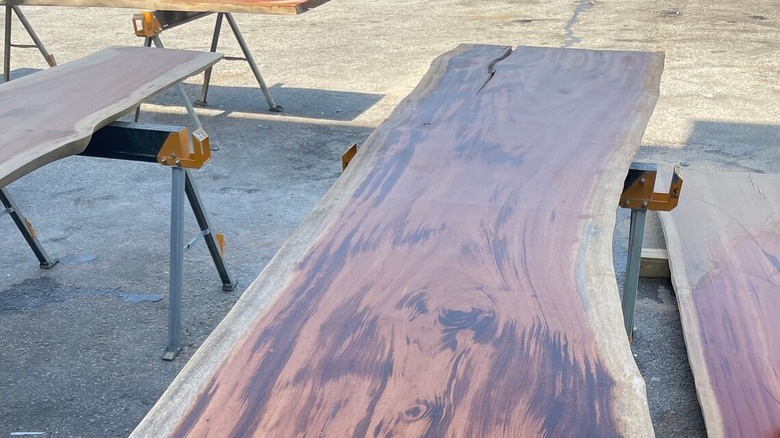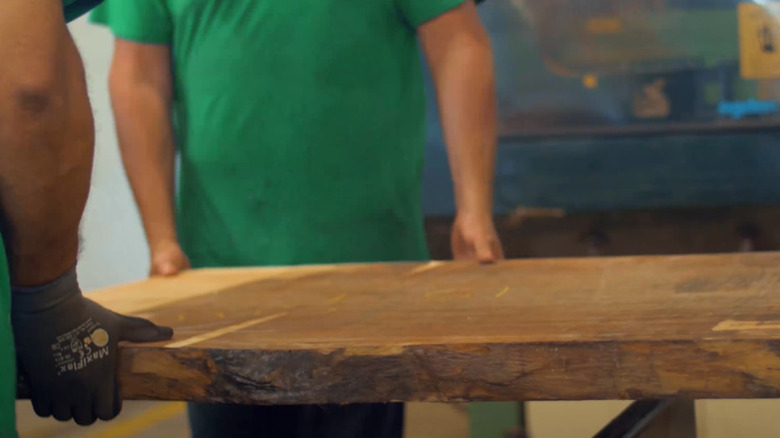This Sturdy Countertop Material Has Unparalleled Strength, But Is It Right For You?
As you shop for a new countertop for your kitchen, you may be ready to move away from using natural stone. If granite and quartz are no longer your style and you're looking for rustic, natural vibes instead, wood can be a good option. One type of wood you may not have thought about using is tigerwood, an impressively beautiful countertop material that's notably one of the hardest woods available. Yet, there are some drawbacks to using this or any type of wood in a busy kitchen that you shouldn't overlook.
Tigerwood is a durable wood that can be used in a variety of applications, including flooring, decking, and kitchen countertops. It's an exotic wood noted for its dramatic tiger-like striped lines that run across it. This type of deep, dark veining can create an impressive look in a kitchen designed to blend modern and natural in a cohesive space. It has a deep red-orange color, which can add interest and a bright color to the space, and the grain pattern is a unique detail.
With all of those benefits, it may seem like an easy choice, but tigerwood can be harder to find than other woods, and once used, you'll need to follow specific strategies for protecting the surface from everyday wear and tear. Also notable is that the color of the wood will change over time as it ages and due to sunlight exposure. It's often best to hire a professional for wood countertop installation.
The benefits of tigerwood countertops in your kitchen
Every slab of tigerwood is unique, bringing with it deep veining and striping and various hues of red to orange coloring. It certainly creates a wow factor in a kitchen. The surface is smooth, with a beautiful but soft grain pattern. If you decide to install it as a countertop, you may also have custom-designed cabinetry, wood paneling, and trim added to your kitchen to match, creating a rustic, cabin-like theme within the space. Alternatively, you could use it in a Tuscan-style kitchen or even an old French-inspired space, as its warm colors easily blend with any style. You can refinish it over time to change the look of the space, too.
Though the aesthetics are fantastic, there are other benefits to adding tigerwood countertops to your kitchen. This wood is highly durable and one of the hardiest options available for busy kitchens. On the Janka scale, which rates how hard a wood is, tigerwood reaches 2,160, while teak measures 1,000 and white oak measures 1,360. That means it can typically handle pots, pans, and items falling on it without significant damage.
While tigerwood is a good work surface when cut as a butcherblock countertop, it isn't always a first choice but could be an option. It's overall moisture-resistant and can be a solid alternative to commercially produced fiberglass or laminate countertops for those who want a natural option.
The downsides of tigerwood countertops
Tigerwood countertops can be a bit unique, and not everyone likes the striping on them as it can create a significant amount of contrast with other colors (that orange hue may not work well with the other aesthetics you plan to put into the space). The wood will eventually change in color, with lighter tones darkening over time resulting in more of a monotone look to the countertop (direct sunlight will increase the likelihood of this happening).
Another factor to consider is that tigerwood isn't superior for eco-friendly designs, unlike other woods. That's because most of this wood is grown deep in rainforests, meaning that accessing it can add to the destruction of these important environments. If you want to be more eco-friendly in kitchen design, look for a product that's more readily available locally.
Finally, be sure to turn to a professional specializing in tigerwood if you decide it's right for you. That's because it's super hard to drill into, making installation difficult in many cases. It typically will need to be custom-cut, conditioned, stained, and sealed for the best long-term durability. You may have to reseal it over time, depending on use, which could give you the added benefit of allowing you to change the coloring a bit over time. Though not as readily available as other options, it's certainly worth exploring how tigerwood countertops could work in your space.


